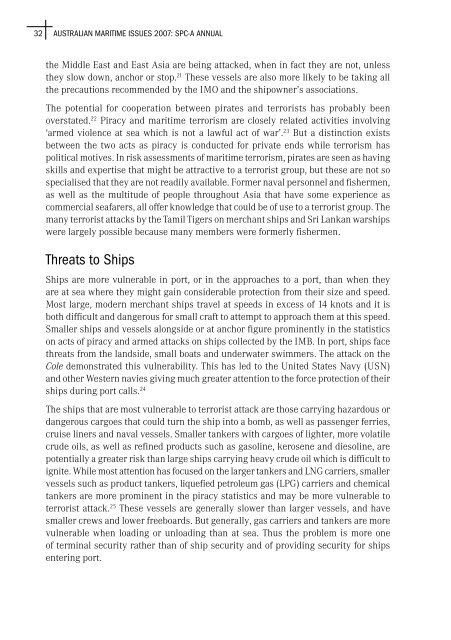Australian Maritime Issues 2007 - Royal Australian Navy
Australian Maritime Issues 2007 - Royal Australian Navy
Australian Maritime Issues 2007 - Royal Australian Navy
Create successful ePaper yourself
Turn your PDF publications into a flip-book with our unique Google optimized e-Paper software.
32 AUSTRALIAN MARITIME ISSUES <strong>2007</strong>: SPC-A ANNUAL<br />
the Middle East and East Asia are being attacked, when in fact they are not, unless<br />
they slow down, anchor or stop. 21 These vessels are also more likely to be taking all<br />
the precautions recommended by the IMO and the shipowner’s associations.<br />
The potential for cooperation between pirates and terrorists has probably been<br />
overstated. 22 Piracy and maritime terrorism are closely related activities involving<br />
‘armed violence at sea which is not a lawful act of war’. 23 But a distinction exists<br />
between the two acts as piracy is conducted for private ends while terrorism has<br />
political motives. In risk assessments of maritime terrorism, pirates are seen as having<br />
skills and expertise that might be attractive to a terrorist group, but these are not so<br />
specialised that they are not readily available. Former naval personnel and fishermen,<br />
as well as the multitude of people throughout Asia that have some experience as<br />
commercial seafarers, all offer knowledge that could be of use to a terrorist group. The<br />
many terrorist attacks by the Tamil Tigers on merchant ships and Sri Lankan warships<br />
were largely possible because many members were formerly fishermen.<br />
Threats to Ships<br />
Ships are more vulnerable in port, or in the approaches to a port, than when they<br />
are at sea where they might gain considerable protection from their size and speed.<br />
Most large, modern merchant ships travel at speeds in excess of 14 knots and it is<br />
both difficult and dangerous for small craft to attempt to approach them at this speed.<br />
Smaller ships and vessels alongside or at anchor figure prominently in the statistics<br />
on acts of piracy and armed attacks on ships collected by the IMB. In port, ships face<br />
threats from the landside, small boats and underwater swimmers. The attack on the<br />
Cole demonstrated this vulnerability. This has led to the United States <strong>Navy</strong> (USN)<br />
and other Western navies giving much greater attention to the force protection of their<br />
ships during port calls. 24<br />
The ships that are most vulnerable to terrorist attack are those carrying hazardous or<br />
dangerous cargoes that could turn the ship into a bomb, as well as passenger ferries,<br />
cruise liners and naval vessels. Smaller tankers with cargoes of lighter, more volatile<br />
crude oils, as well as refined products such as gasoline, kerosene and diesoline, are<br />
potentially a greater risk than large ships carrying heavy crude oil which is difficult to<br />
ignite. While most attention has focused on the larger tankers and LNG carriers, smaller<br />
vessels such as product tankers, liquefied petroleum gas (LPG) carriers and chemical<br />
tankers are more prominent in the piracy statistics and may be more vulnerable to<br />
terrorist attack. 25 These vessels are generally slower than larger vessels, and have<br />
smaller crews and lower freeboards. But generally, gas carriers and tankers are more<br />
vulnerable when loading or unloading than at sea. Thus the problem is more one<br />
of terminal security rather than of ship security and of providing security for ships<br />
entering port.
















